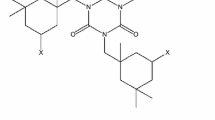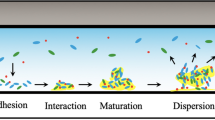Abstract
A laminar flow biofilm-monitoring system was used to determine the efficacies of three antifouling (AF) coatings and five fouling-release (FR) coatings againstVibrio harveyi attachment. On-line measurements of tryptophan fluorescence and bioluminescence from each coating, normalized to an upstream stainless steel coupon, were used to determine the effects of AF and FR surfaces on biofilm formation. The AF coatings consisted of 5, 10, and 35 wt% Sea Nine 211 (C9211) incorporated into a vinyl copolymer. Both the 10 and 35 wt% coatings significantly inhibited biofilm biomass development measured by tryptophan fluorescence compared to the stainless steel control.V. harveyi bioluminescence was significantly greater than tryptophan fluorescence in cells attached to these coatings, suggesting that bioluminescence expression may be a marker for cellular stress or toxicity in biofilms. Five different polydimethylsiloxane (PDMS) FR coatings did not inhibit biofilm formation under low flow conditions. However, four PDMS coatings demonstrated decreased biomass levels compared to stainless steel after exposure to a shear stress of 330 dynes cm−2. There was no toxic additive in these coatings; bioluminescence and tryptophan fluorescence were proportional.
Similar content being viewed by others
References
Alberte RS, S Snyder, BJ Zahuranec and M Whetstone. 1992. Biofouling research needs for the United States Navy: program history and goals. Biofouling 6:91–95.
Angell P, AA Arrage, MW Mittelman and DC White. 1993. On-line, non-destructive biomass determination of bacterial biofilms by fluorometry. J Microbiol Methods 18: 317–327.
Baier RE and AE Meyer. 1992. Surface analysis of fouling-resistant marine coatings. Biofouling 6: 165–180.
Bohlander GS. 1991. Biofilm effects on drag: measurements on ships. In: Polymers in a Marine Environment (Bufton R, P Yakimiuk and K Williams, eds), pp. 135–138, Marine Management (Holdings) Ltd, London.
DeBeer D, P Stoodley, F Roe and Z Lewandowski. 1993. Oxygen distribution and mass transport in biofilms. Biotechnol Bioeng 43: 1131–1138.
Evans LV and N Clarkson. 1993. Antifouling strategies in the marine environment. J Appl Bact (Suppl) 74: 119S-124S.
Hastings JW and KH Nealson. 1977. Bacterial bioluminescence. Ann Rev Microbiol 31:549–595.
Holmstrom C, D Rittschof and S Kjelleberg. 1992. Inhibition of settlement by larvae ofBalanus amphitrite andCiona intestinalis by a surface-colonizing marine bacterium. Appl Environ Microbiol 58: 2111–2115.
Jack RF, DB Ringelberg and DC White. 1992. Differential corrosion rates of carbon steel by combinations ofBacillus sp,Hafnia alvei andDesulfovibrio gigas established by phospholipid analysis of electrode biofilm. Corrosion Science 33: 1843–1853.
Lawrence JR, GM Wolfaardt and DR Korber. 1994. Determination of diffusion coefficients in biofilms by confocal laser microscopy. Appl Environ Microbiol 60: 1166–1173.
Marshall KC. 1980. Bacterial adhesion in natural environments. In: Microbial Adhesion to Surfaces (Berkeley RCW, JM Lynch, J Melling, PR Rutter and B Vincent, eds), pp 187–194, Ellis Horwood, Chichester, UK.
Mitchell R and JS Maki. 1988. Microbial surface films and their influence on larval settlement and metamorphosis in the marine environment. In: Marine Biodeterioration: Advanced Techniques Applicable to the Indian Ocean (Thompson M-F, R Sarojini and R Nagabhushanam, eds), pp 489–497, Oxford & IBH Publishing Co, New Delhi.
Mittelman MW, JMH King, GS Sayler and DC White. 1992. On-line detection of bacterial adhesion in a shear gradient with bioluminescence by aPseudomonas fluorescens (lux) strain. J Microbiol Methods 15: 53–60.
Mittelman MW, J Packard, AA Arrage, SL Bean, P Angell and DC White. 1993. Test systems for determining antifouling coating efficacy using on-line detection of bioluminescence and fluorescence in a laminar-flow environment. J Microbiol Methods 18: 51–60.
Murray RE, KE Cooksey and JC Priscu. 1987. Influence of physical disruption on growth of attached bacteria. Appl Environ Microbiol 53: 2997–2999.
Rutter PR and B Vincent. 1980. The adhesion of micro-organisms to surfaces: physico-chemical aspects. In: Microbial Adhesion to Surfaces (Berkeley RCW, JM Lynch, J Melling, PR Rutter and B Vincent, eds), pp 79–92, Ellis Horwood, Chichester, UK.
Stoodley P, D deBeer and Z Lewandowski. 1994. Liquid flow in biofilm systems. Appl Environ Microbiol 60: 2711–2716.
Ulitzur S, A Reinhertz and JW Hastings. 1981. Factors affecting the cellular expression of bacterial luciferase. Arch Microbiol 129: 67–71.
Weisman GR, DC Sundberg, RA Cimini, MG Brown, BR Beno and TT Eighmy. 1992. Controlled release antifouling coatings. I. Approaches for controlled release of 2,4-dinitrophenolate and benzoate into seawater. Biofouling 6: 123–146.
Author information
Authors and Affiliations
Rights and permissions
About this article
Cite this article
Arrage, A.A., Vasishtha, N., Sundberg, D. et al. On-line monitoring of antifouling and fouling-release surfaces using bioluminescence and fluorescence measurements during laminar flow. Journal of Industrial Microbiology 15, 277–282 (1995). https://doi.org/10.1007/BF01569980
Received:
Accepted:
Issue Date:
DOI: https://doi.org/10.1007/BF01569980




